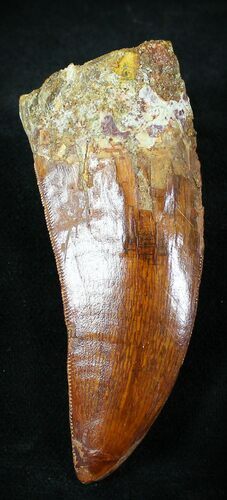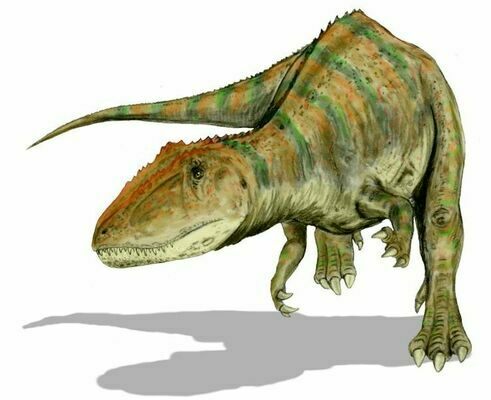This Specimen has been sold.
Beautiful, Curved 2.81" Carcharodontosaurus Tooth
This killer 2.81" long, tooth of the gigantic predatory dinosaur Carcharodontosaurus saharicus. This massive theropod often gets compared to T-Rex but is actually thought be larger and is much older.
Very nice, mahogany colored enamel preservation on this long, curved tooth. The serrations are a bit worn, but most are still visible along both the inner and outer edge. Only some minimal feeding wear to the tip. There are a few crack repairs and some small areas of gap fill restoration in the cracks. This is much less work than you typically see on the larger Carcharodontosaurus teeth, which often come out of the ground in pieces.
Very nice, mahogany colored enamel preservation on this long, curved tooth. The serrations are a bit worn, but most are still visible along both the inner and outer edge. Only some minimal feeding wear to the tip. There are a few crack repairs and some small areas of gap fill restoration in the cracks. This is much less work than you typically see on the larger Carcharodontosaurus teeth, which often come out of the ground in pieces.
About Carcharodontosaurus
Carcharodontosaurus comprised a genus of dinosaurs that dominated the land during the mid-Cretaceous Period, between 100-93 million years ago. This genus currently includes two gigantic species, which were among the largest known predatory dinosaurs. They were immense as the genera Tyrannosaurus and Giganotosaurus, but not as colossal as Spinosaurus.
Along with the spinosaurids, carcharodontosaurids were the largest predators in the early and middle Cretaceous throughout Gondwana, with species also present in North America (Acrocanthosaurus), and Asia (Shaochilong). Various scientists submit length estimates for C. saharicus, ranging between 12 and 13 m (39-43.5 ft) and weight estimates between 6 and 15 metric tons.
Carcharodontosaurids were a scourge of the land as giant, shark-toothed terrors in a world of monsters. Though spinosaurids would have been a formidable enemy, they may have occupied a semi-aquatic niche, which reduced competition. Both giant hunters also shared their world with menacing, 30-foot ancient crocodiles that had a taste for dinosaur.
Past the Turonian (93.9-89.8 mya), Carcharodontosaurus might have been replaced by the smaller abelisaurids in Gondwana and by tyrannosaurids in North America and Asia. The disappearance of carcharodontosaurids, spinosaurids, and other fauna in Gondwana and across the world suggests a global replacement event. Despite the event, fossils discovered in Brazil, which appear to be carcharodontosaurids, indicate some survivors of this group until the latest stage of the Cretaceous.
Carcharodontosaurus comprised a genus of dinosaurs that dominated the land during the mid-Cretaceous Period, between 100-93 million years ago. This genus currently includes two gigantic species, which were among the largest known predatory dinosaurs. They were immense as the genera Tyrannosaurus and Giganotosaurus, but not as colossal as Spinosaurus.
Along with the spinosaurids, carcharodontosaurids were the largest predators in the early and middle Cretaceous throughout Gondwana, with species also present in North America (Acrocanthosaurus), and Asia (Shaochilong). Various scientists submit length estimates for C. saharicus, ranging between 12 and 13 m (39-43.5 ft) and weight estimates between 6 and 15 metric tons.
Carcharodontosaurids were a scourge of the land as giant, shark-toothed terrors in a world of monsters. Though spinosaurids would have been a formidable enemy, they may have occupied a semi-aquatic niche, which reduced competition. Both giant hunters also shared their world with menacing, 30-foot ancient crocodiles that had a taste for dinosaur.
Past the Turonian (93.9-89.8 mya), Carcharodontosaurus might have been replaced by the smaller abelisaurids in Gondwana and by tyrannosaurids in North America and Asia. The disappearance of carcharodontosaurids, spinosaurids, and other fauna in Gondwana and across the world suggests a global replacement event. Despite the event, fossils discovered in Brazil, which appear to be carcharodontosaurids, indicate some survivors of this group until the latest stage of the Cretaceous.
SPECIES
Carcharodontosaurus saharicus
LOCATION
Taouz, Kem Kem Basin, Morocco
FORMATION
Kem Kem Beds
SIZE
2.81" long (straightline)
CATEGORY
SUB CATEGORY
ITEM
#23369
We guarantee the authenticity of all of our specimens.
 Reviews
Reviews













